Bài giảng Hệ điều hành Linux - Bài: Các thao tác quản trị hệ thống cơ bản - Ngô Văn Công
Siêu tài khoản người dùng(superuser account)
Quá trình khởi động và thoát khỏi hệ thống
Quản lý tài khoản người dùng
Quản lý hệ thống tập tin
Quản lý pakage
Điều khiển các tiến trình

Trang 1
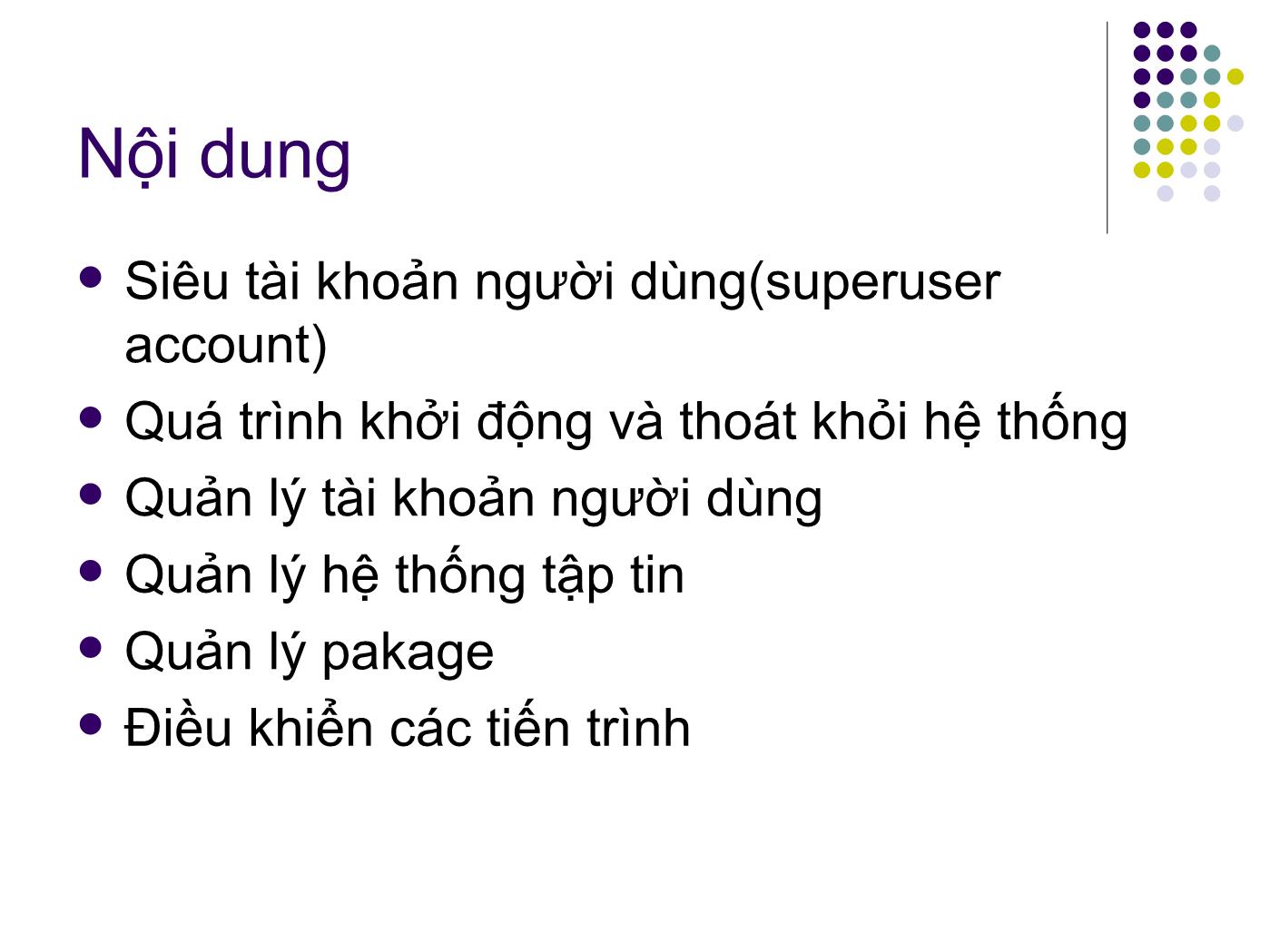
Trang 2
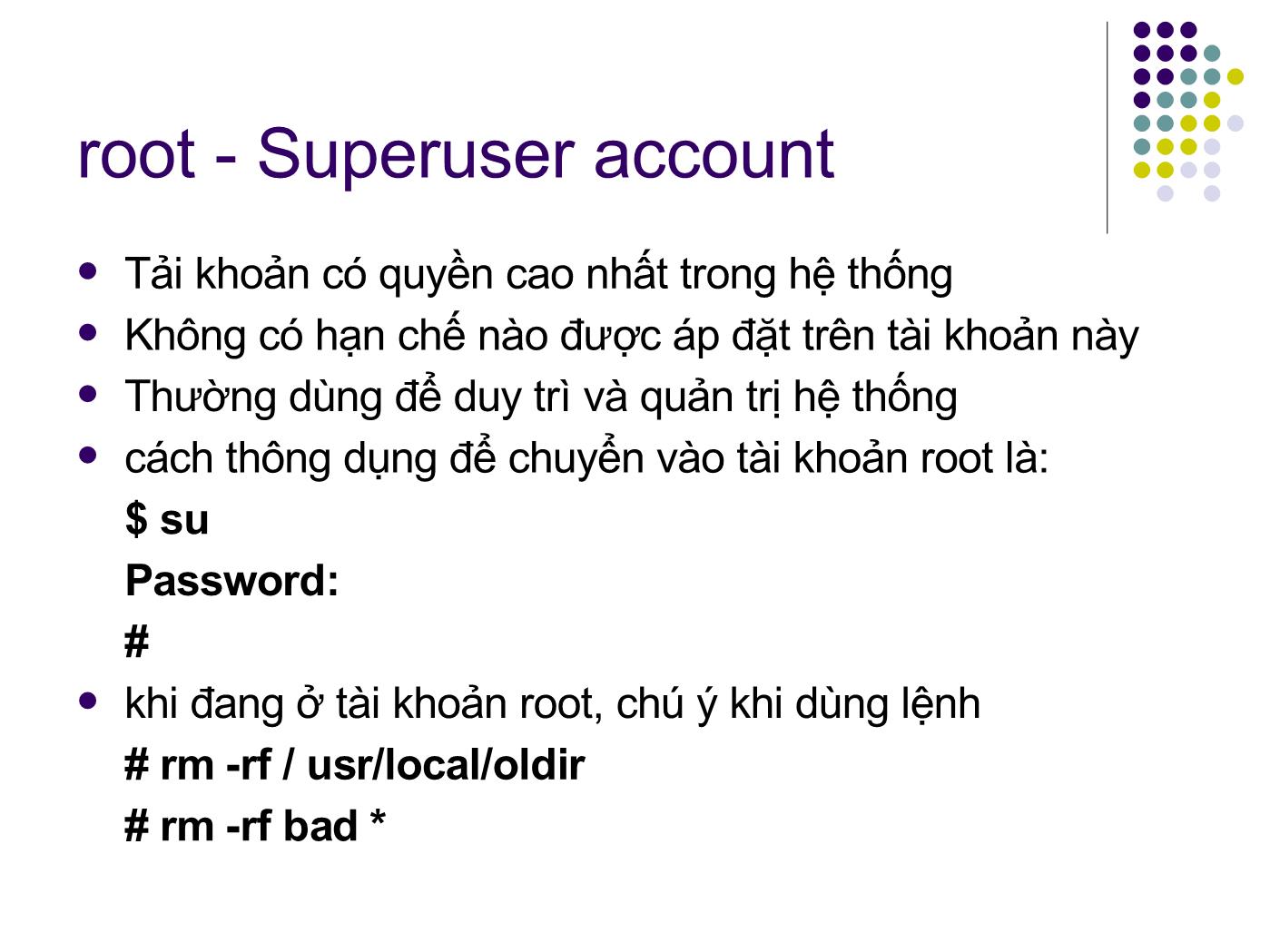
Trang 3
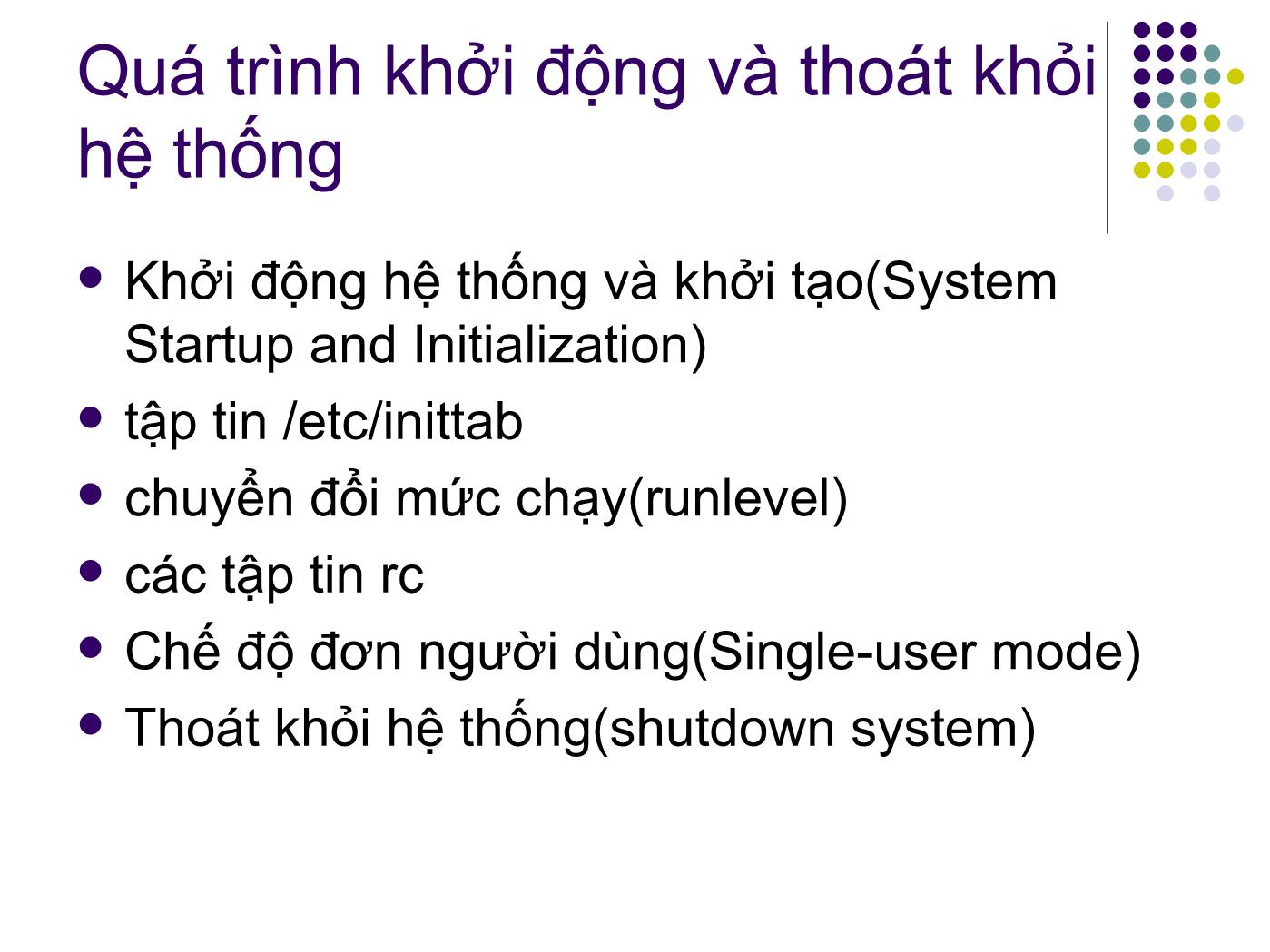
Trang 4
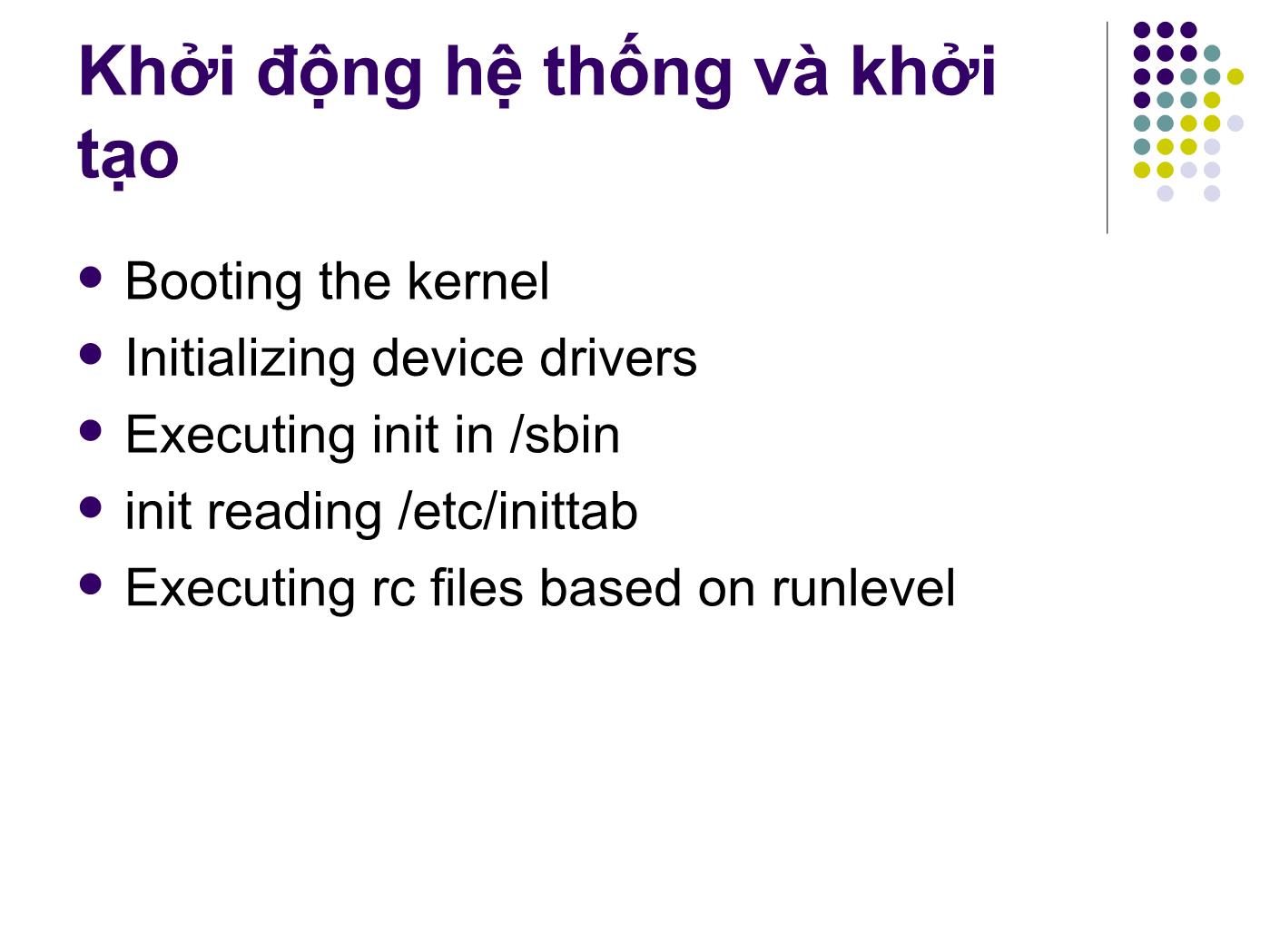
Trang 5

Trang 6
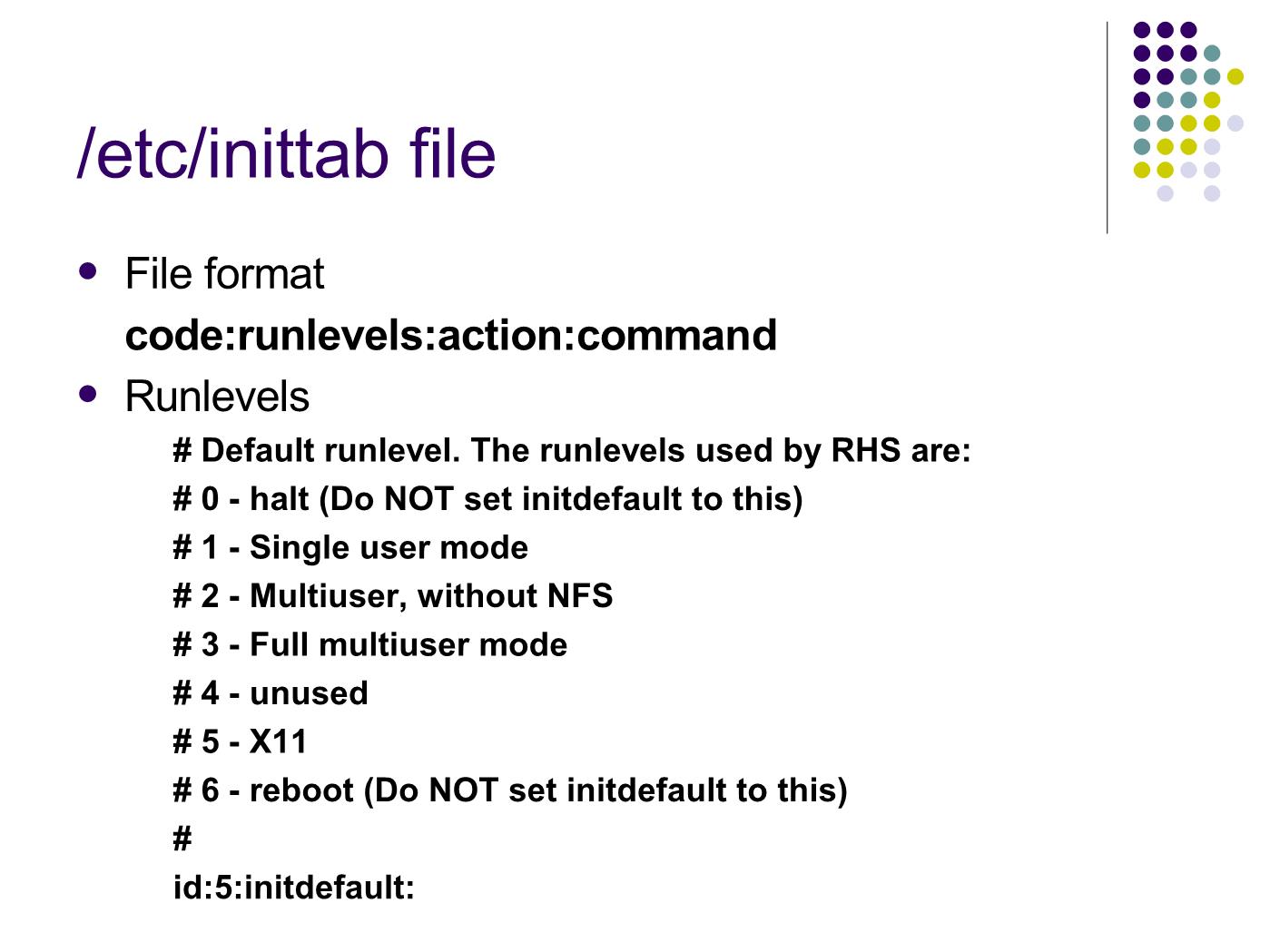
Trang 7

Trang 8
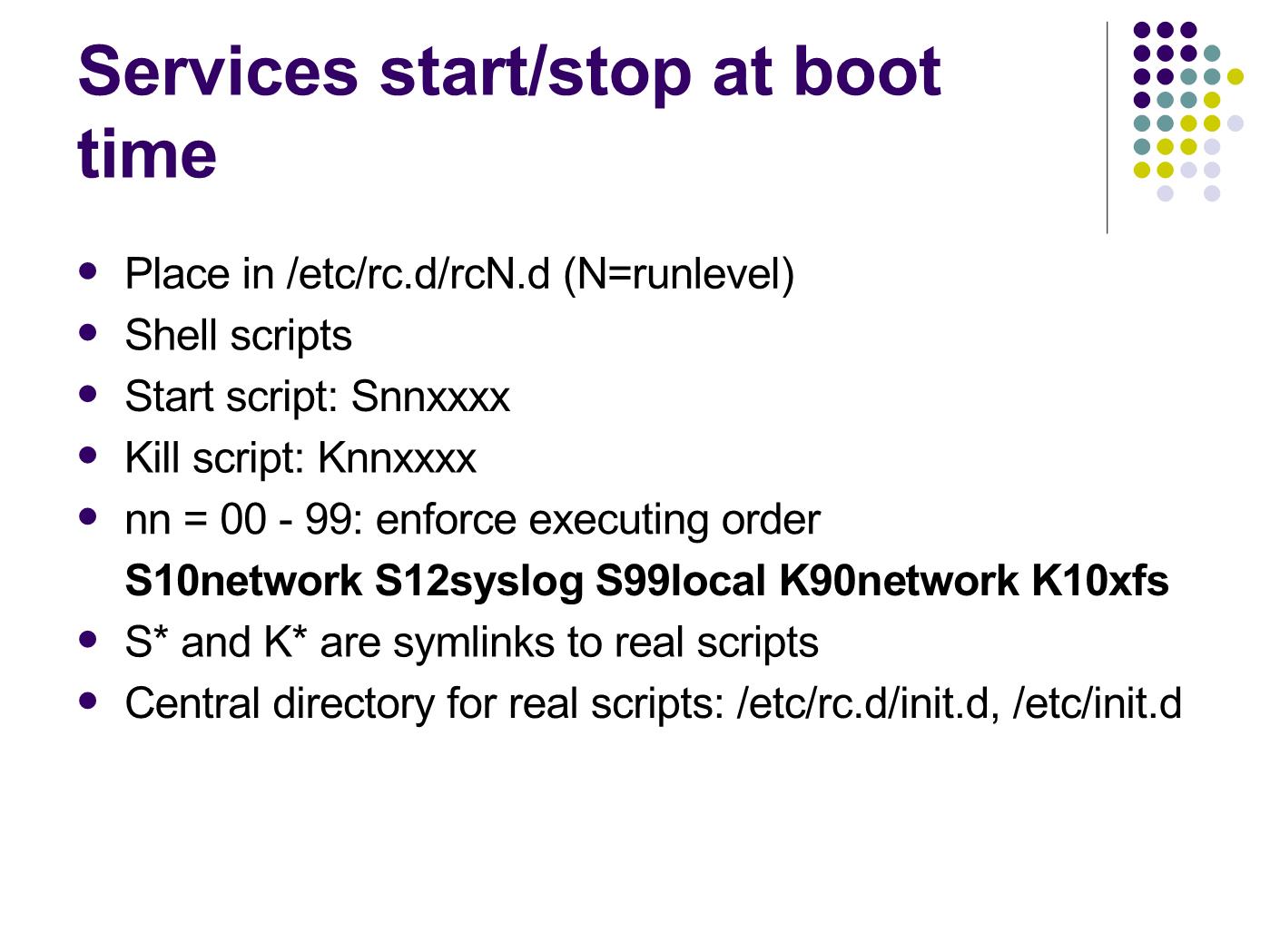
Trang 9
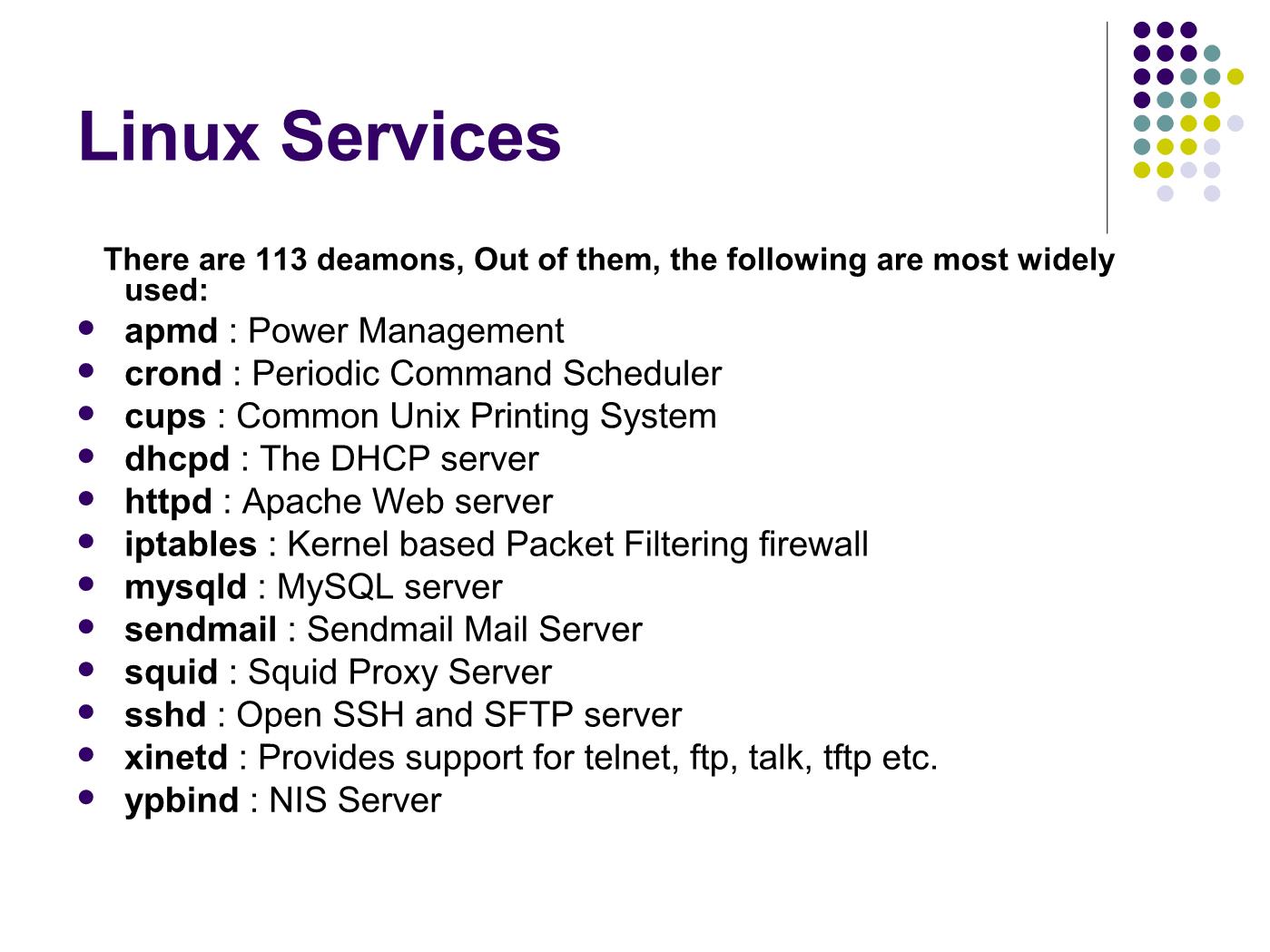
Trang 10
Tải về để xem bản đầy đủ
Bạn đang xem 10 trang mẫu của tài liệu "Bài giảng Hệ điều hành Linux - Bài: Các thao tác quản trị hệ thống cơ bản - Ngô Văn Công", để tải tài liệu gốc về máy hãy click vào nút Download ở trên
Tóm tắt nội dung tài liệu: Bài giảng Hệ điều hành Linux - Bài: Các thao tác quản trị hệ thống cơ bản - Ngô Văn Công

Các thao tác quản trị hệ thống cơ bản Ngô Văn Công Nội dung Siêu tài khoản người dùng(superuser account) Quá trình khởi động và thoát khỏi hệ thống Quản lý tài khoản người dùng Quản lý hệ thống tập tin Quản lý pakage Điều khiển các tiến trình root - Superuser account Tải khoản có quyền cao nhất trong hệ thống Không có hạn chế nào được áp đặt trên tài khoản này Thường dùng để duy trì và quản trị hệ thống cách thông dụng để chuyển vào tài khoản root là: $ su Password: # khi đang ở tài khoản root, chú ý khi dùng lệnh # rm -rf / usr/local/oldir # rm -rf bad * Quá trình khởi động và thoát khỏi hệ thống Khởi động hệ thống và khởi tạo(System Startup and Initialization) tập tin /etc/inittab chuyển đổi mức chạy(runlevel) các tập tin rc Chế độ đơn người dùng(Single-user mode) Thoát khỏi hệ thống(shutdown system) Khởi động hệ thống và khởi tạo Booting the kernel Initializing device drivers Executing init in /sbin init reading /etc/inittab Executing rc files based on runlevel Kernel init /etc/inittab 3 /etc/rc3.d /etc/rc3.d/[SK]* 5 /etc/rc5.d /etc/rc5.d/[SK]* Boot loader(LILO,GRUB) /etc/init.d/syslogd /etc/init/mysqld . /etc/cupsd Symbol link 0 1 2 3 4 5 6 /etc/inittab file File format code:runlevels:action:command Runlevels # Default runlevel. The runlevels used by RHS are: # 0 - halt (Do NOT set initdefault to this) # 1 - Single user mode # 2 - Multiuser, without NFS # 3 - Full multiuser mode # 4 - unused # 5 - X11 # 6 - reboot (Do NOT set initdefault to this) # id:5:initdefault: Switching runlevel Generally, Linux operates in runlevel 3 or 5 Edit initdefault in /etc/inittab Running init manually # init 5 (switch to X11 mode) # init 3 (switch to multiuser mode) # init 1 (switch to single user mode) Finding previous and current system run level # runlevel N 5 Services start/stop at boot time Place in /etc/rc.d/rcN.d (N=runlevel) Shell scripts Start script: Snnxxxx Kill script: Knnxxxx nn = 00 - 99: enforce executing order S10network S12syslog S99local K90network K10xfs S* and K* are symlinks to real scripts Central directory for real scripts: /etc/rc.d/init.d, /etc/init.d Linux Services There are 113 deamons, Out of them, the following are most widely used: apmd : Power Management crond : Periodic Command Scheduler cups : Common Unix Printing System dhcpd : The DHCP server httpd : Apache Web server iptables : Kernel based Packet Filtering firewall mysqld : MySQL server sendmail : Sendmail Mail Server squid : Squid Proxy Server sshd : Open SSH and SFTP server xinetd : Provides support for telnet, ftp, talk, tftp etc. ypbind : NIS Server (tt) Start and stop daemon If a startup script exists in the /etc/init.d directory (tt) Fedora and Redhat also come with the service command Chế độ đơn người dùng(Single- User Mode) Trong tình trạng khẩn cấp, phục hồi lại hệ thống No login prompt Truy cập với người dùng root Chỉ ở chế console boot: linux single boot: linux -s boot: linux 1 # init 1 shutdown hệ thống shutdown - tắt hệ thống # shutdown -r +10 (reboot after 10 minutes) # /sbin/shutdown -r +10 "Rebooting to try new kernel" # shutdown -h now (halt immediately) Other ways Ctrl-Alt-Del # reboot # halt # poweroff Quản lý tài khoản Người dùng và nhóm Tạo, chỉnh sửa, xóa tài khoản người dùng /etc/passwd file /etc/shadow file Tạo, chỉnh sửa, xóa nhóm /etc/group file Người dùng và nhóm Tài khoàn người dùng và tài khoản hệ thống mỗi người dùng sẽ có 1 tên và định danh(id) duy nhất (unsigned number) Mỗi người dùng thuộc về ít nhất 1 nhóm Mỗi nhóm có tên và định danh duy nhất (unsigned number) Tên tài khoản người dùng thường là chữ thường Tài khoản siêu người dùng luôn có id là 0 Thêm tài khoản người dùng useradd [-u uid] [-g group] [-G group,...] [-d home] [-s shell] [-c comment] name # useradd -g students -c "Student 001" stud001 passwd - set user password # passwd stud001 Chỉnh sửa và xoá tài khoản người dùng usermod [-u uid] [-g group] [-G group,...] [-d home] [-s shell] [-c comment] [-l new_name] name # usermod -u 1001 stud001 userdel [-r] name -r: remove user’s home directory # userdel -r stud001 /etc/passwd file File format username:password:uid:gid:gecos:homedir:shell username - bất kỳ chuỗi ký tự nào dùng để xác định tài khoản (human convenient) password - mật khẩu người dùng(mã hóa) uid - user ID (system convenient) gid - group ID gecos - thông tin khác của người dùng homedir - thư mục home của người dùng shell - chương trình sẽ chạy khi người dùng login vào, thường là /bin/bash Tăng bảo mật cho mật khẩu: /etc/shadow Ví dụ các mục trong /etc/passwd root:x:0:0:root:/root:/bin/bash bin:x:1:1:bin:/bin:/sbin/nologin nobody:x:99:99:Nobody:/:/sbin/nologin xfs:x:43:43:X Font Server:/etc/X11/fs:/bin/false student:x:500:500:Student:/home/student:/bin/bash Tập tin /etc/shadow /etc/shadow chứa thông tin mật khẩu đã được mã hóa cho tài khoản người dùng Login name Encrypted password (tt) Khóa tài khoản người dùng Đặt ! trong trường password của tập tin /etc/shadow Thay đổi shell đăng nhập thành /sbin/nologin Tài khoản nhóm Adding group groupadd [-g gid] group # groupadd students Modifying group groupmod [-g gid] [-n name] group # groupmod -g 1000 students Deleting group groupdel group # groupdel students Tập tin /etc/group Định dạng groupname:password:gid:members groupname - bất kỳ chuỗi ký tự nào password - tùy chọn mật khẩu gid - group ID members - danh sách người dùng, phân cách bằng dấu , Ví dụ các mục trong /etc/group root:x:0:root bin:x:1:root,bin,daemon student:x:500: Chỉnh sửa người sở hữu và nhóm chown - Thay đổi người sở hữu và nhóm # chown -R stud001:students /home/stud001 Cấp quyền root khi chạy 1 lệnh: lệnh s
File đính kèm:
 bai_giang_he_dieu_hanh_linux_bai_cac_thao_tac_quan_tri_he_th.pdf
bai_giang_he_dieu_hanh_linux_bai_cac_thao_tac_quan_tri_he_th.pdf

